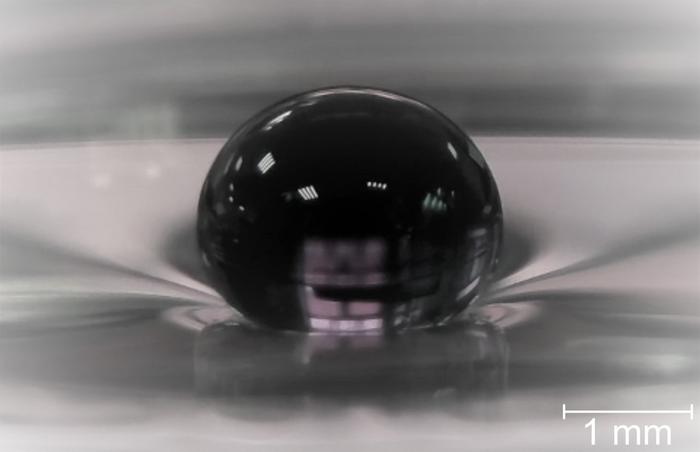WASHINGTON, July 18, 2023 – Self-sustained levitation of millimeter-sized droplets was recently discovered by researchers at Tyumen State University, in Russia, during an experiment to select combinations of immiscible liquids, which don’t form homogeneous mixtures.

Credit: Natalia Ivanova and Denis Klyuev
WASHINGTON, July 18, 2023 – Self-sustained levitation of millimeter-sized droplets was recently discovered by researchers at Tyumen State University, in Russia, during an experiment to select combinations of immiscible liquids, which don’t form homogeneous mixtures.
Researchers Natalia Ivanova and Denis Klyuev noticed something amazing happen: Droplets of butyl alcohol, after being detached from the syringe needle, levitated above the surface of the layer of another liquid without collapsing onto it for a long period of time.
In Applied Physics Letters, from AIP Publishing, they report achieving self-sustaining and long-term levitation of millimeter-sized droplets of several different liquids — without any external forces.
What was it like to see the droplets levitate? “It was amazing,” said Ivanova. “The phenomenon of noncoalescence of droplets with an underlying liquid is well known. But under natural conditions, a droplet levitates above a liquid pool only an instant — milliseconds, at most. We witnessed a droplet continue to levitate for tens of minutes.”
To get the droplets to levitate, they use solutocapillary convection within a pool of silicone liquid. Solutocapilllary convection occurs when a surface tension gradient is formed by nonuniform distribution of vapor molecules from the droplet at the pool surface.
“Sometimes interesting and miraculous phenomena lie right in front of us and we don’t notice them,” said Ivanova. “By focusing on a certain task, we begin to think ‘tunnel-like’ to some extent and stop noticing alternative approaches to problem solving.”
Typically, to keep the droplets levitating for a long time — from seconds to a long-term period — it’s necessary to continuously generate excess pressure inside an ultrathin gap between a droplet and the surface of underlying liquid. This can be achieved via different methods, such as using vibrations so a droplet acts as if it’s jumping or by creating air flows within the gap under the droplet.
“The latter includes rolling the droplet over the liquid surface, or actively evaporating one of them by, for example, taking advantage of the Leidenfrost effect,” said Klyuev. “There are also magnetic or acoustic levitation methods, but they all have one thing in common: we either do external work on the system or initially create nonequilibrium conditions so that long-term levitation of the droplet can be provided only during their existence.”
Further exploring the effects of various external conditions on self-sustained droplet levitation will reveal whether it can be harnessed and adapted for microbiology and biochemistry applications.
Ivanova and Klyuev believe the effect of long-term self-sustained droplet levitation can be helpful to develop scientific tools to explore the diversity and activity of microorganisms and to improve the understanding of heat and mass transfer within a vapor film.
“Since the topic of droplet levitation is quite popular, we expect solutocapillary convection levitation will be considered by other researchers — since the problem is quite interesting from the point of view of modeling microscale transport,” said Ivanova. “We will also continue our work to establish the influence of external factors on this system.”
###
The article “Self-sustaining levitation of droplets above a liquid pool” is authored by Natalia Ivanova and Denis Klyuev. It will appear in Applied Physics Letters on July 18, 2023 (DOI: 10.1063/5.0152920). After that date, it can be accessed at https://doi.org/10.1063/5.0152920.
ABOUT THE JOURNAL
Applied Physics Letters features rapid reports on significant discoveries in applied physics. The journal covers new experimental and theoretical research on applications of physics phenomena related to all branches of science, engineering, and modern technology. See https://pubs.aip.org/aip/apl.
###
Journal
Applied Physics Letters
DOI
10.1063/5.0152920
Article Title
Self-sustaining levitation of droplets above a liquid pool
Article Publication Date
18-Jul-2023




